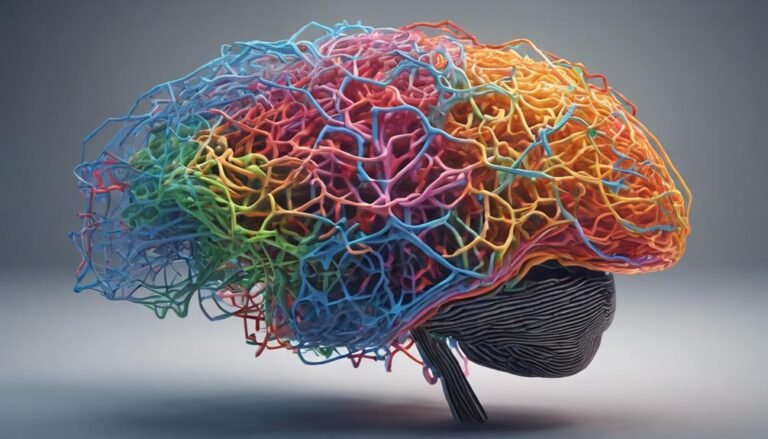Emerging Theories in Personality Psychology
You may not be aware that traditional trait-based frameworks in personality psychology are being challenged by newer theories that emphasize dynamic systems, interpersonal interactions, and neurobiological influences. These emerging perspectives offer a fresh lens through which to view individual differences and behavior patterns, shedding light on the intricate interplay between internal processes and external factors. As you explore these evolving theories, you will uncover a rich tapestry of concepts that broaden our understanding of personality development and the complexities of human nature.
Key Takeaways
- Cognitive Experiential Self-Theory integrates intuition and analysis in decision-making.
- Dynamic Systems Approach emphasizes complex system dynamics in personality development.
- Interpersonal Circumplex Model maps interpersonal interactions based on warmth and dominance.
- Integrated Trait-States Theory explores enduring traits and situational states in behavior outcomes.
- Polythetic Trait Model highlights trait combinations and behavior outcomes for a nuanced perspective.
Trait Theory Revisions
Recent developments in personality psychology have prompted significant revisions to traditional trait theory, challenging long-held assumptions and expanding our understanding of individual differences. Personality assessment methods have been scrutinized for validity concerns, leading to a reevaluation of trait theory’s foundational principles.
Researchers have begun to acknowledge the cultural implications that influence the assessment of personality traits, recognizing that certain traits may be valued differently across cultures, thereby impacting the interpretation of assessment results.
Trait theory, once thought to provide a universal framework for understanding personality, is now being viewed through a more culturally sensitive lens. The acknowledgment of cultural influences on trait expression has emphasized the need for a more nuanced approach to personality assessment.
Cognitive Experiential Self-Theory
The exploration of Cognitive Experiential Self-Theory offers a new perspective on personality dynamics, expanding beyond traditional trait theory frameworks. This theory posits that individuals have two systems for processing information – experiential (intuitive, automatic) and rational (analytical, deliberate).
Here are three key aspects to take into account when delving into Cognitive Experiential Self-Theory:
- Self-Reflection Techniques: Cognitive Experiential Self-Theory emphasizes the importance of engaging in self-reflection techniques to better understand one’s intuitive and analytical thinking processes. By reflecting on past experiences and decisions, individuals can gain insight into their thought patterns and behaviors.
- Emotional Intelligence Assessment: This theory underscores the significance of emotional intelligence assessment in understanding how individuals process and regulate emotions. By considering emotional intelligence levels, individuals can identify strengths and areas for growth in managing their emotions effectively.
- Integration of Intuition and Analysis: Cognitive Experiential Self-Theory highlights the integration of intuitive and analytical processes in decision-making. By balancing these two systems, individuals can make well-informed choices that align with their values and goals.
Dynamic Systems Approach
When you delve into the Dynamic Systems Approach in personality psychology, you’ll encounter a thorough overview of system dynamics and an in-depth analysis of developmental trajectories. This approach emphasizes the interconnectedness of various factors that influence personality development over time.
System Dynamics Overview
One way to understand personality development is through the lens of system dynamics, which offers a holistic perspective on the intricate interplay of various factors influencing an individual’s behavior and traits. Within the domain of complex systems and personality dynamics, system dynamics theory emphasizes the following key points:
- Feedback Loops: System dynamics highlight the significance of feedback loops in shaping personality development. Positive feedback loops can reinforce certain behaviors or traits, leading to stability, while negative feedback loops may introduce changes or adaptations over time.
- Stability and Change: The concept of stability and change is central to understanding personality dynamics within complex systems. System dynamics theory suggests that personalities exhibit stability in certain traits while also allowing for flexibility and adaptation to changing environments or life experiences.
- Holistic Approach: System dynamics offer a holistic approach to studying personality development, considering the interconnectedness of various factors such as genetics, environment, social interactions, and personal experiences in shaping an individual’s behavior and traits. By examining the dynamic interactions within a system, researchers can gain valuable insights into the complexities of personality development.
Developmental Trajectories Analysis
To explore further the understanding of personality development, consider investigating Developmental Trajectories Analysis through the Dynamic Systems Approach, which offers a thorough framework for examining the evolving patterns and interactions shaping an individual’s personality over time. Longitudinal studies play an essential role in this analysis, as they track individuals across various stages of life, providing valuable insights into how personality traits unfold and change over the lifespan. By observing these long-term trends, researchers can identify key developmental milestones and understand the factors that influence personality development.
Furthermore, cross-cultural comparisons of personality trajectories allow researchers to explore how cultural contexts impact the shaping of personality. This comparative approach helps in recognizing universal patterns as well as cultural-specific influences on personality development. By examining how individuals from different cultural backgrounds experience and express personality traits over time, researchers can gain a deeper understanding of the complex interplay between culture and personality development.
Interpersonal Circumplex Model
Within the field of personality psychology, the Interpersonal Circumplex Model provides a structured framework for understanding and analyzing interpersonal behavior. This model maps out interpersonal interactions based on two main dimensions: warmth and dominance. By placing various behaviors and traits on this circumplex, researchers can analyze how individuals differ in their interpersonal dynamics and how these differences influence social interactions.
The circular structure of the Interpersonal Circumplex Model makes it easy to visualize and understand the complexities of interpersonal behaviors.
This model captures individual differences in interpersonal styles, highlighting how unique personality traits can affect social interactions.
The Interpersonal Circumplex Model enhances personality assessment by providing a detailed framework to analyze how individuals navigate social relationships.
Integrated Trait-States Theory
You’re about to explore the intricate dynamics of Trait-States Interaction within the framework of Integrated Trait-States Theory. Understanding the Neurobiological Correlates of Traits will shed light on how personality manifests at a biological level.
Moreover, analyzing the Practical Applications and Implications of this theory will showcase its relevance in various real-world contexts.
Trait-States Interaction Dynamics
The Integrated Trait-States Theory explores the dynamic interplay between enduring personality traits and situational states. This theory investigates how these two factors interact to influence an individual’s behavior and experiences.
Here are three key insights regarding Trait-States Interaction Dynamics:
- State dynamics, personality traits: The theory emphasizes that while personality traits serve as stable characteristics, they can manifest differently based on the situational context. For instance, an individual high in extraversion may exhibit different behaviors in a social gathering compared to a work setting, showcasing the impact of situational states on trait expression.
- Interaction patterns, behavior outcomes: By studying how personality traits and situational states interact, researchers can identify patterns in behavior outcomes. Understanding these patterns can provide valuable insights into predicting and explaining why individuals behave in certain ways in specific situations.
- Adaptability and consistency: Trait-States Interaction Dynamics highlights the balance between adaptability to situational demands and the consistency of personality traits. Individuals can adjust their behavior based on the situation while still demonstrating their core traits, showcasing the complexity of human personality.
Neurobiological Correlates of Traits
Exploring the neurobiological correlates of personality traits within the framework of the Integrated Trait-States Theory sheds light on the biological underpinnings influencing individual behavior and experiences. Neurobiological markers play an essential role in understanding how specific traits manifest in an individual.
Research has shown that certain personality traits are associated with distinct patterns of brain activity and neurotransmitter levels. For example, individuals high in openness to experience may exhibit increased activity in brain regions related to creativity and cognitive flexibility.
Moreover, the link between neurobiology and personality traits extends to genetic factors. Studies have identified specific gene variations that are associated with certain traits, highlighting the complex interplay between genetics, neurobiology, and personality.
Understanding these neurobiological underpinnings of traits can provide valuable insights into individual differences in behavior, cognition, and emotional responses.
Practical Applications and Implications
Practical applications and implications of the Integrated Trait-States Theory encompass a wide range of contexts where understanding neurobiological correlates of personality traits can inform decision-making and interventions.
Here are three key areas where this theory can have a significant impact:
- Clinical Interventions and Therapeutic Techniques:
By delving into the neurobiological underpinnings of personality traits, therapists and mental health professionals can tailor interventions more effectively. For instance, insight into how specific traits manifest at a neurobiological level can aid in developing personalized treatment plans for individuals with various personality disorders.
- Workplace Applications and Leadership Strategies:
Understanding how traits influence behavior at a neurobiological level can enhance leadership development programs. Employers can utilize this knowledge to create more effective leadership strategies tailored to individuals’ unique personality traits, fostering better workplace dynamics and productivity.
- Personal Development and Growth:
Individuals can use insights from the Integrated Trait-States Theory to enhance self-awareness and personal growth. By understanding how their traits manifest neurobiologically, individuals can make informed decisions about their personal and professional development paths.
Polythetic Trait Model
An innovative approach within personality psychology, the Polythetic Trait Model offers a nuanced perspective on understanding individual differences. This model emphasizes trait combinations and how they interact to influence behavior outcomes. Unlike traditional models that focus on single traits, the Polythetic Trait Model recognizes the complexity of personality assessment and the importance of trait diversity in shaping an individual’s behavior.
By considering multiple traits simultaneously, this model captures the intricate interplay between different aspects of personality and how they collectively contribute to an individual’s unique behavioral tendencies. This approach acknowledges that people aren’t defined by a single trait but rather by a combination of various traits that work together to influence their actions and reactions in different situations.
The Polythetic Trait Model highlights the dynamic nature of personality and how trait configurations can lead to a wide range of behavioral outcomes. It provides a more all-encompassing understanding of individuals by acknowledging the complexity and diversity of traits that contribute to their overall personality.
Person X Situation Interactions
Understanding how individuals’ personalities interact with various situational factors is essential in predicting their behavioral responses. Personality traits and situational factors play a significant role in shaping how individuals behave in different circumstances.
Here are three key points worth noting:
- Trait Activation Theory: This theory suggests that certain personality traits become more prominent depending on the situation. For example, an introverted individual may exhibit extroverted behavior in social settings that they find comfortable, highlighting the dynamic nature of personality-situation interactions.
- Person-Situation Fit: The concept of person-situation fit emphasizes that individuals will respond differently based on how well their personality traits align with the demands of a particular situation. A person with high levels of conscientiousness may excel in structured environments where their organizational skills are valued.
- Interactionist Perspective: This perspective underscores the idea that both personality traits and situational factors interact to influence behavior. It recognizes that individuals bring their unique characteristics into different situations, leading to varied responses based on this interplay.
Multidimensional Nomological Network
You can explore the intricate web of network associations within personality psychology and the nomological relationships that are being meticulously examined.
By understanding the multidimensional nomological network, researchers can uncover the intricate connections between various personality traits and behaviors, shedding light on the complex interplay at play.
This approach offers a thorough framework for studying and analyzing the multifaceted nature of personality and its interactions within diverse contexts.
Network Associations in Personality
Recent advancements in personality psychology have shed light on the intricate network associations present within the multidimensional nomological network. Understanding network associations in personality involves exploring how different traits interconnect and influence each other within an individual’s psychological framework. This concept explores the complex web of relationships between various personality traits and how they collectively shape an individual’s overall behavioral patterns and characteristics.
When exploring network associations in personality, it’s essential to take into account:
- Trait Associations: Examining how specific traits are interconnected and how they manifest in different contexts can provide valuable insights into an individual’s psychological makeup.
- Personality Networks: Analyzing the interconnectedness of various personality traits within an individual’s psyche can offer a thorough understanding of their behavioral tendencies and reactions.
- Influence of Environment: Recognizing how external factors interact with internal traits in shaping personality networks highlights the dynamic nature of individual differences and behavior.
Nomological Relationships Explored
Examining the interconnectedness of personality traits within the multidimensional nomological network reveals the intricate web of relationships shaping individual behavioral patterns. Personality stability, influenced by both genetic predispositions and environmental factors, plays a vital role in understanding how traits interact to form a cohesive behavioral profile. External influences, such as upbringing and social experiences, contribute substantially to the development and expression of personality characteristics.
Moreover, within this network, the concept of predictive validity emerges as a pivotal factor. By examining how certain traits or combinations of traits relate to specific behavioral outcomes, researchers can gain insights into the consistency and reliability of personality assessments. Understanding the predictive power of different traits not only enhances our ability to anticipate individual actions but also sheds light on the underlying mechanisms driving behavior.
Narrative Identity Theory
Narrative Identity Theory posits that individuals construct their sense of self through the weaving of personal experiences into coherent and evolving narratives. This theory emphasizes the significance of storytelling in shaping one’s identity and understanding of the world around them. Here are three key aspects to ponder:
- Identity Formation: Through the process of narrative construction, individuals piece together their past experiences, present actions, and future aspirations to create a cohesive self-concept. This ongoing narrative helps individuals make sense of their lives and establish a sense of continuity and purpose.
- Self-Reflection: Engaging in the construction of life narratives encourages individuals to reflect on their values, beliefs, and goals. By examining the stories they tell about themselves, individuals gain insight into their motivations, strengths, and areas for growth.
- Personal Growth: As individuals continuously revise and reinterpret their life narratives, they’ve the opportunity to learn from past experiences, adapt to new challenges, and work towards a more authentic and fulfilling sense of self. This process of narrative identity construction is dynamic, allowing for personal growth and self-discovery over time.
Socio-Cognitive Integration Model
The Socio-Cognitive Integration Model explores how individuals’ social interactions influence their cognitive processes and decision-making. In understanding socio-cognitive development, this model emphasizes the significance of group dynamics in shaping an individual’s thought processes and behaviors.
Social cognition plays a vital role in how people perceive themselves within a group context and how they integrate their personality traits with their social roles.
By delving into the intricate interplay between social dynamics and cognitive functioning, the Socio-Cognitive Integration Model provides valuable insights into how individuals navigate complex social environments. It highlights the reciprocal relationship between social interactions and cognitive processes, illustrating how these factors mutually influence each other.
Through this lens, researchers can better comprehend the mechanisms underlying personality integration within social contexts.
Conclusion
As you traverse through the landscape of personality psychology, charting the winding paths of trait theory revisions and dynamic systems approaches, you discover a rich tapestry of interconnected theories.
Like a skilled artist blending colors on a canvas, these emerging theories weave together the threads of individual differences, social interactions, and neurobiological influences to create a masterpiece of understanding.
Embrace the complexity, embrace the interconnectedness, and reveal the hidden depths of human personality.







